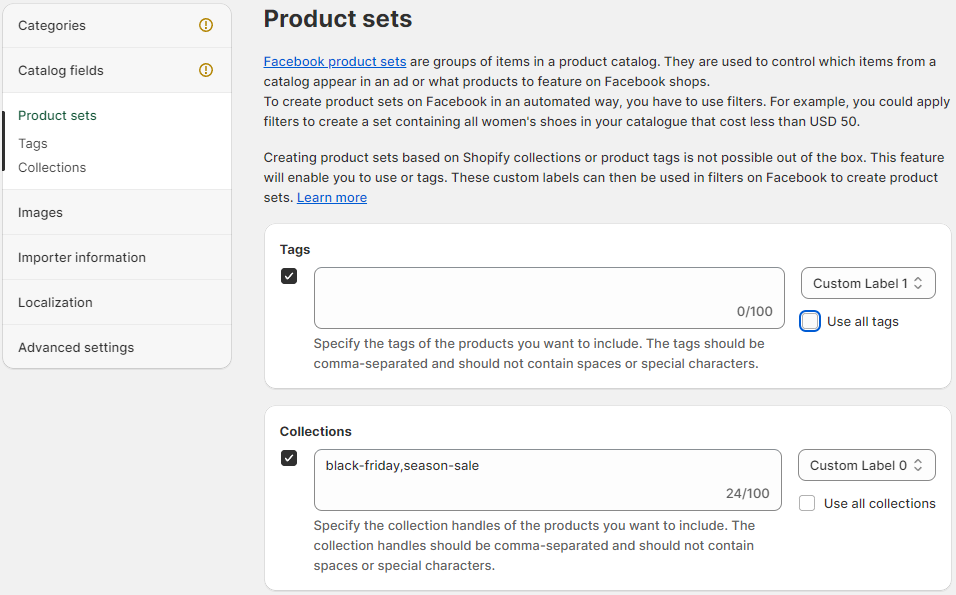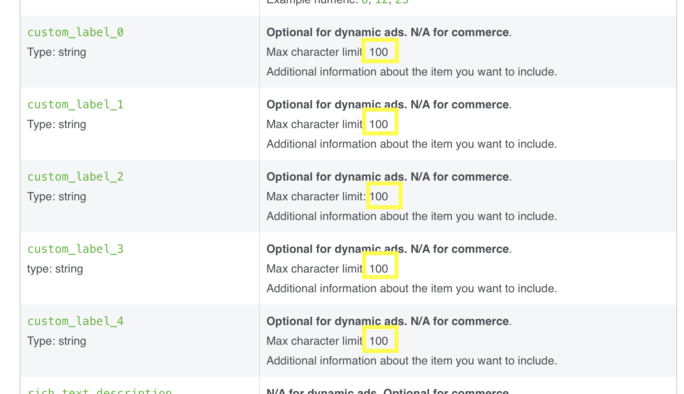Sometimes you want to create groups of products to target in your ads. E.g. special sales or specific types of products. Most Shopify merchants organize their products in groups by leveraging Collections & Tags. It's only natural then to re-use those tags & collections on online ad platforms. That is what the "Product Segments" feature allows you to do.

Facebook calls these product groups "product sets", and Google calls them "product group subdivisions". We call them Product Segments. Here's how it works:
- In your Flexify Admin you specify a comma-separated list of tags or collections, e.g. "tag1,tag2" or "collectionA,collectionB".
- You select which custom_label field you want to use.
- If a product has one of the specified tags or is a member of one of the specified collections, that tag or collection is copied into the custom_label field.
- On Facebook, you can then create a product set for each tag or collection using the "contains" rule.
- Similarly, on Google, you can then create a product group subdivision for each tag or collection using the "contains" rule.
The end result is that you can target your ads to specific collections.
Please see the detailed steps in our tutorial "How to use product segments to target ads to specific collections by creating product sets on Facebook?"
or tags Tutorial "How to create on Facebook product segments filtered by Shopify tag?".
While for product segmentation you can use only one custom label with a tag and another with a collection handle, to provide additional information for your products, you can utilize the other custom labels with the metafields.
Please find more details in our help article "Custom Labels".
[2021-07-16 | Updates]
- We do not limit the number of characters anymore for the whitelist of tags or collections that should be included in the product feed.
- It is now possible to just use all tags or collections.
Basically, the feature got more powerful, but it is now the responsibility of the merchant to ensure that the character limit is enforced by Facebook.
The following message will be shown on Facebook if the custom label is above 100 characters:

In this case, the custom label attribute will be ignored. In other words, there will be no values of the label in the catalog.
So you have to make sure the tags and/or the collection handles in the custom label fields don’t exceed 100 characters in length:

More info in the Facebook documentation: Facebook Help Documentation
Example:
- Suppose we have three collections "baby,women,men".
- Their URLs are the following:
http://shopname.myshopify.com/... collection handles are "baby", "women" & "men" - You enter the following values in the collection segmentation field: "baby,men"
- You select custom_label_0
- This means that on Facebook you will be able to create product sets for "baby" & "men" but NOT for "women".
- To create a product set for "baby" you enter "baby" in the "contains" filter rule for custom_label_0 on Facebook.
- To create a product set for "women" you enter "women" in the "contains" filter rule and you enter "men" in the "does not contain" filter rule for custom_label_0 on Facebook.
Important Tips:
- Enter your collection's "Collection Handle". This is the part after "/collections/" in the URL of your collection on your Shopify store. E.g. For a collection that is available under
http://store.myshopify.com/collections/sale... enter "sales" - Do not use capital letters for your collection handles or tags.
- Your list of collections or tags should be comma-separated & contain no spaces or special characters. E.g. "tag1,tag2" & "collectionA,collectionB".
- Take note of which of the five available custom_label fields you use. Your segments will only be available in those custom_labels on Facebook & Google.
- The limit of 100 characters is outside of our control & imposed by the technical spec used by Facebook & Google.
- In order to make the best use of this character limit, you can edit your collection handle down to a 2-letter character code by modifying the SEO title of a collection.
- If you are using segments to build product sets on Facebook make sure you use the "contains" filter rule and type in the "EXACT" tag name or collection handle, please don't rely on FB's autocomplete.
- Tags aren't case sensitive. For example,
Approvedandapprovedare the same tag. Use only ordinary letters, numbers, and hyphens (-) in your tags. Accented characters and other symbols can exclude search results.
